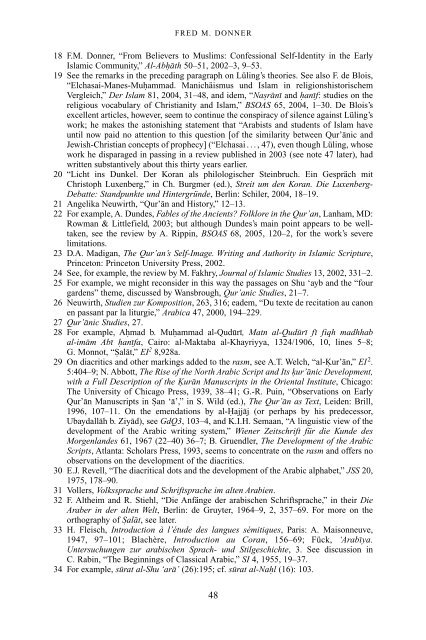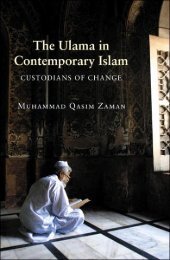The Qur'an in its historical context (pdf - Islam and Christian-Muslim ...
The Qur'an in its historical context (pdf - Islam and Christian-Muslim ...
The Qur'an in its historical context (pdf - Islam and Christian-Muslim ...
Create successful ePaper yourself
Turn your PDF publications into a flip-book with our unique Google optimized e-Paper software.
FRED M. DONNER<br />
18 F.M. Donner, “From Believers to <strong>Muslim</strong>s: Confessional Self-Identity <strong>in</strong> the Early<br />
<strong>Islam</strong>ic Community,” Al-Abhath 50–51, 2002–3, 9–53.<br />
19 See the remarks <strong>in</strong> the preced<strong>in</strong>g paragraph on Lül<strong>in</strong>g’s theories. See also F. de Blois,<br />
“Elchasai-Manes-Muhammad. Manichäismus und <strong>Islam</strong> <strong>in</strong> religionshistorischem<br />
Vergleich,” Der <strong>Islam</strong> 81, 2004, 31–48, <strong>and</strong> idem, “Nasrani <strong>and</strong> hanif: studies on the<br />
religious vocabulary of <strong>Christian</strong>ity <strong>and</strong> <strong>Islam</strong>,” BSOAS 65, 2004, 1–30. De Blois’s<br />
excellent articles, however, seem to cont<strong>in</strong>ue the conspiracy of silence aga<strong>in</strong>st Lül<strong>in</strong>g’s<br />
work; he makes the astonish<strong>in</strong>g statement that “Arabists <strong>and</strong> students of <strong>Islam</strong> have<br />
until now paid no attention to this question [of the similarity between Qur’anic <strong>and</strong><br />
Jewish-<strong>Christian</strong> concepts of prophecy] (“Elchasai..., 47), even though Lül<strong>in</strong>g, whose<br />
work he disparaged <strong>in</strong> pass<strong>in</strong>g <strong>in</strong> a review published <strong>in</strong> 2003 (see note 47 later), had<br />
written substantively about this thirty years earlier.<br />
20 “Licht <strong>in</strong>s Dunkel. Der Koran als philologischer Ste<strong>in</strong>bruch. E<strong>in</strong> Gespräch mit<br />
Christoph Luxenberg,” <strong>in</strong> Ch. Burgmer (ed.), Streit um den Koran. Die Luxenberg-<br />
Debatte: St<strong>and</strong>punkte und H<strong>in</strong>tergründe, Berl<strong>in</strong>: Schiler, 2004, 18–19.<br />
21 Angelika Neuwirth, “Qur’an <strong>and</strong> History,” 12–13.<br />
22 For example, A. Dundes, Fables of the Ancients? Folklore <strong>in</strong> the Qur’an, Lanham, MD:<br />
Rowman & Littlefield, 2003; but although Dundes’s ma<strong>in</strong> po<strong>in</strong>t appears to be welltaken,<br />
see the review by A. Ripp<strong>in</strong>, BSOAS 68, 2005, 120–2, for the work’s severe<br />
limitations.<br />
23 D.A. Madigan, <strong>The</strong> Qur’an’s Self-Image. Writ<strong>in</strong>g <strong>and</strong> Authority <strong>in</strong> <strong>Islam</strong>ic Scripture,<br />
Pr<strong>in</strong>ceton: Pr<strong>in</strong>ceton University Press, 2002.<br />
24 See, for example, the review by M. Fakhry, Journal of <strong>Islam</strong>ic Studies 13, 2002, 331–2.<br />
25 For example, we might reconsider <strong>in</strong> this way the passages on Shu ‘ayb <strong>and</strong> the “four<br />
gardens” theme, discussed by Wansbrough, Qur’anic Studies, 21–7.<br />
26 Neuwirth, Studien zur Komposition, 263, 316; eadem, “Du texte de recitation au canon<br />
en passant par la liturgie,” Arabica 47, 2000, 194–229.<br />
27 Qur’anic Studies, 27.<br />
28 For example, Ahmad b. Muhammad al-Quduri, Matn al-Quduri fi fiqh madhhab<br />
al-imam Abi hanifa, Cairo: al-Maktaba al-Khayriyya, 1324/1906, 10, l<strong>in</strong>es 5–8;<br />
G. Monnot, “Salat,” EI 2 8,928a.<br />
29 On diacritics <strong>and</strong> other mark<strong>in</strong>gs added to the rasm, see A.T. Welch, “al-Üur’an,” EI 2 .<br />
5:404–9; N. Abbott, <strong>The</strong> Rise of the North Arabic Script <strong>and</strong> Its üur’anic Development,<br />
with a Full Description of the Üuran Manuscripts <strong>in</strong> the Oriental Institute, Chicago:<br />
<strong>The</strong> University of Chicago Press, 1939, 38–41; G.-R. Pu<strong>in</strong>, “Observations on Early<br />
Qur’an Manuscripts <strong>in</strong> San ‘a’,” <strong>in</strong> S. Wild (ed.), <strong>The</strong> Qur’an as Text, Leiden: Brill,<br />
1996, 107–11. On the emendations by al-Hajjaj (or perhaps by his predecessor,<br />
Ubaydallah b. Ziyad), see GdQ3, 103–4, <strong>and</strong> K.I.H. Semaan, “A l<strong>in</strong>guistic view of the<br />
development of the Arabic writ<strong>in</strong>g system,” Wiener Ze<strong>its</strong>chrift für die Kunde des<br />
Morgenl<strong>and</strong>es 61, 1967 (22–40) 36–7; B. Gruendler, <strong>The</strong> Development of the Arabic<br />
Scripts, Atlanta: Scholars Press, 1993, seems to concentrate on the rasm <strong>and</strong> offers no<br />
observations on the development of the diacritics.<br />
30 E.J. Revell, “<strong>The</strong> diacritical dots <strong>and</strong> the development of the Arabic alphabet,” JSS 20,<br />
1975, 178–90.<br />
31 Vollers, Volkssprache und Schriftsprache im alten Arabien.<br />
32 F. Altheim <strong>and</strong> R. Stiehl, “Die Anfänge der arabischen Schriftsprache,” <strong>in</strong> their Die<br />
Araber <strong>in</strong> der alten Welt, Berl<strong>in</strong>: de Gruyter, 1964–9, 2, 357–69. For more on the<br />
orthography of Salat, see later.<br />
33 H. Fleisch, Introduction à l’étude des langues sémitiques, Paris: A. Maisonneuve,<br />
1947, 97–101; Blachère, Introduction au Coran, 156–69; Fück, ‘Arabiya.<br />
Untersuchungen zur arabischen Sprach- und Stilgeschichte, 3. See discussion <strong>in</strong><br />
C. Rab<strong>in</strong>, “<strong>The</strong> Beg<strong>in</strong>n<strong>in</strong>gs of Classical Arabic,” SI 4, 1955, 19–37.<br />
34 For example, surat al-Shu ‘ara’ (26):195; cf. surat al-Nahl (16): 103.<br />
48



